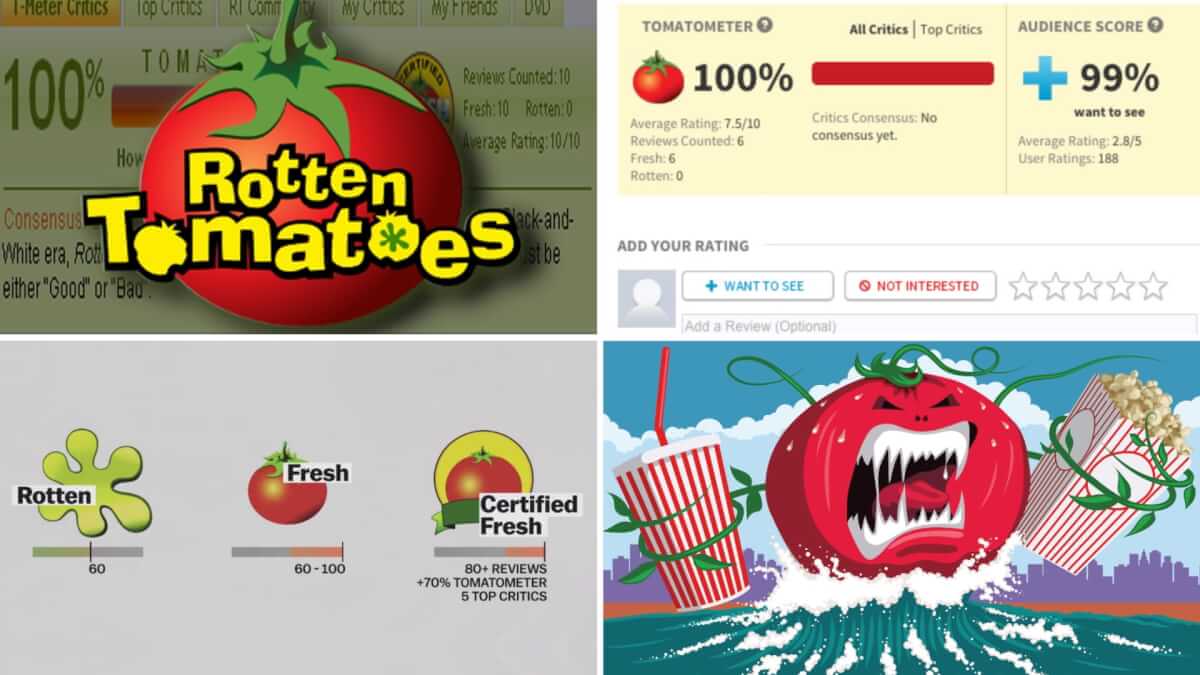The Rotten Tomatoes ratings system―good or bad? Well, I’d say it’s a bit better than the original way tomatoes were used to judge entertainment. Because even if we want to throw fruit at the screen, 21st century technology reminds us we don’t have to. Rotten Tomatoes will provide us with a fair Critic consensus before we even get to the theatre (saving us a ton of food and money).
So how does Rotten Tomatoes work, exactly? Is it a reliable judge of… characters… Okay, okay, hold your tomatoes please. Let’s get a behind the scenes look at how it all works.
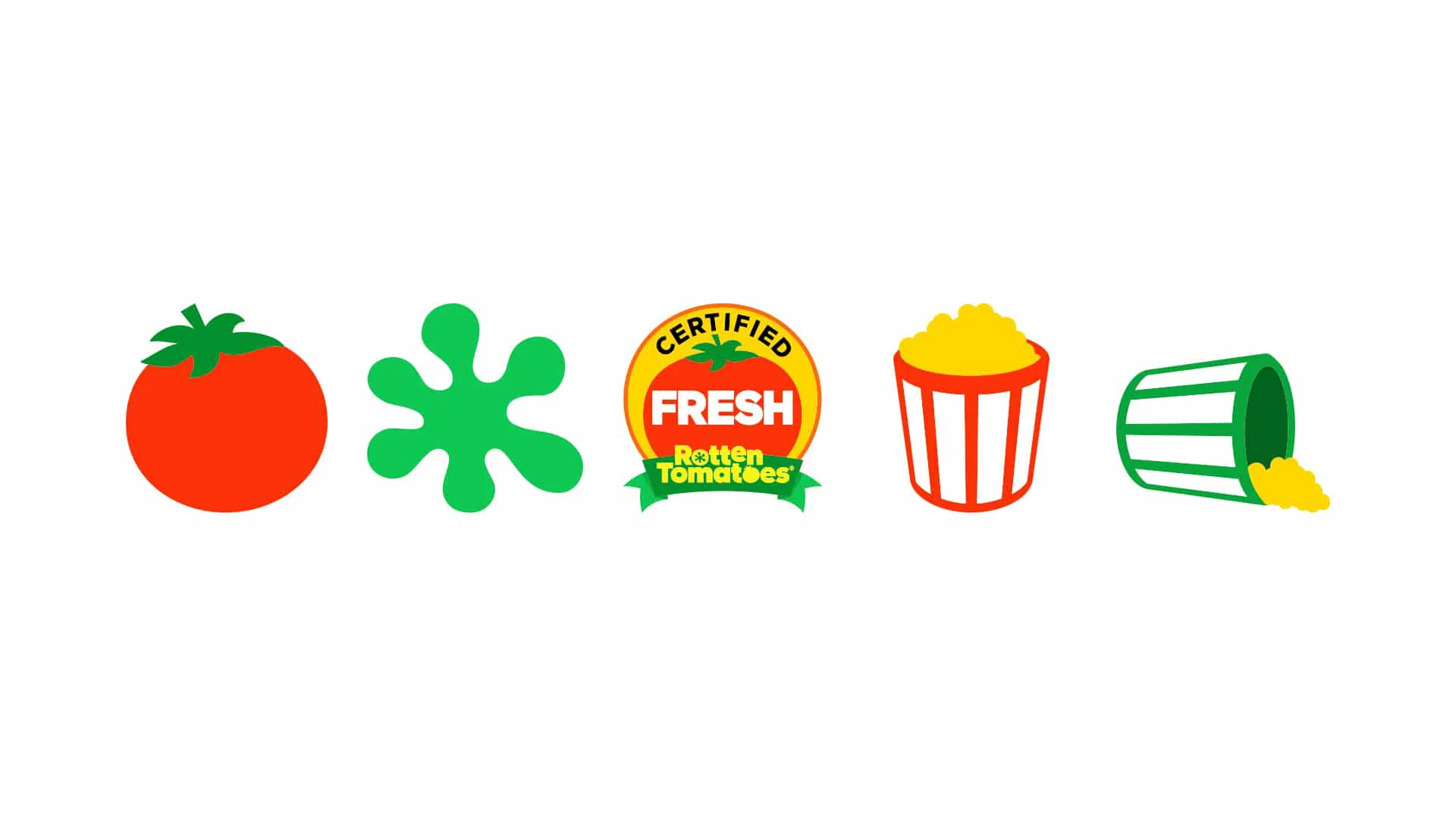
What do the Rotten Tomatoes symbols mean? Read on
How Does Rotten Tomatoes Work?
Rotten Tomatoes Ratings System
Rotten Tomatoes started in 2000 and it quickly became moviegoers go-to for reviews. But ever since Fandango acquired the company, it’s become even more well-known adding something called a “Tomatometer” score next to every movie and ticket listing.
Critics have suggested that there is much more nuance and complication when it comes to the correlation between a Rotten Tomatoes rating and ticket sales. And while we will not get into that in this article, I think there is something to be said psychologically about seeing a rating right before you make your choice.
But I digress.
I know for me, the ubiquitous nature of a Rotten Tomatoes score has made me feel like they hold more weight than they once did. But do they really hold more weight? How is the score actually calculated? And how are critics curated?
Let's break it down.
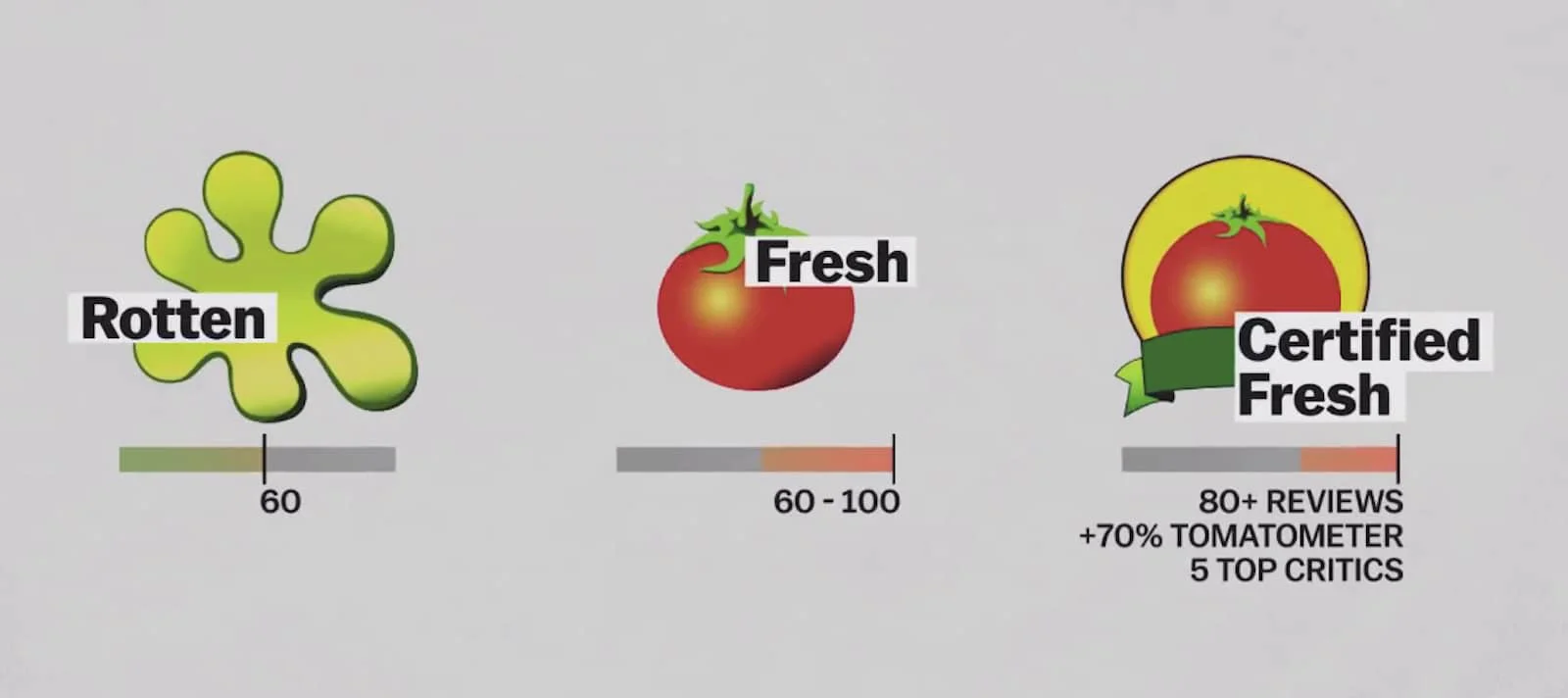
Tomatometer Breakdown
Rotten Tomatoes Rating System
How does the Tomatometer work?
The Rotten Tomatoes rating system uses a scale better known as the “The Tomatometer.” This represents the percentage of positive reviews for a given film or show. The Tomatometer score is calculated after five reviews.
As the reviews come in, The Tomatometer measures the positive reviews against the negative ones and assigns either an overall score of fresh or rotten rating to the film or television show.
A red tomato score indicating its fresh status, is designated when at least 60% of the reviews are positive.
A green splat indicating rotten status, is displayed when less than 60% of the reviews are positive.
If there is no score available, it usually just means the movie or show hasn’t been released or there aren’t enough reviews yet. So, now that we know how they’re calculated, who’s doing the reviewing?
Related Posts
How Does Rotten Tomatoes Rate Their Movies
How is Rotten Tomatoes rated?
Rotten Tomatoes is careful in its Critic curation. It won’t include just any critic’s review. It aggregates those who have been regularly putting out movie reviews over the last two years, and those who are considered active by Rotten Tomatoes standards. This just means they’ve published a review within the last year. While there are about 3,000 accepted reviewers (see the Tomatometer-approved critics criteria), usually only several hundred are actively reviewing for any given film.
Many times, it’s much less. And Top Critics are counted with a separate score. So while the the Rotten Tomatoes rating system is really just general consensus, you can see some of the more renowned critics in a different space.
But it’s not just about the critics! You also get a fully rounded out review because you can also see how the audience feels.
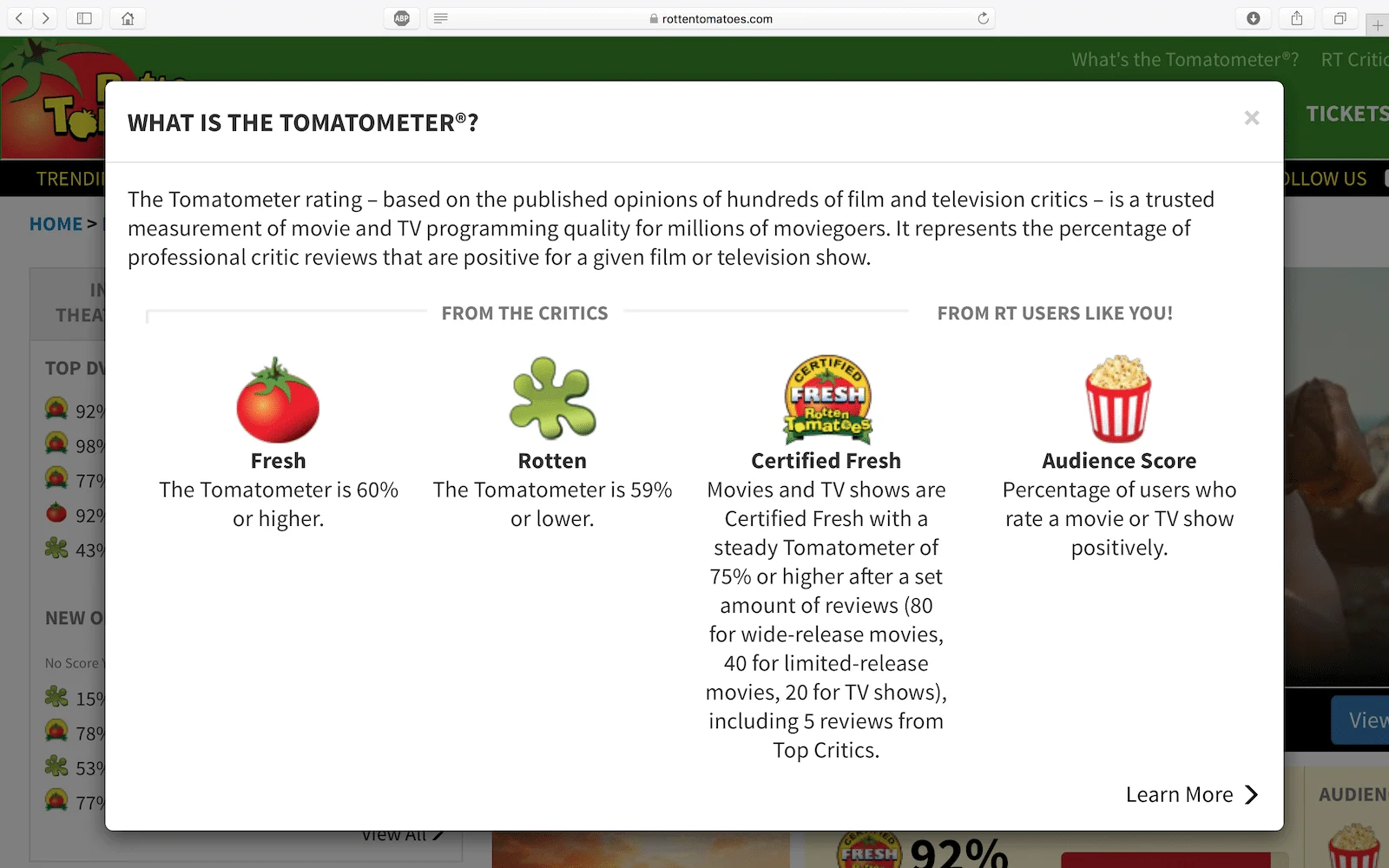
What is the Tomatometer?
Popcorn Rating Explained
Rotten Tomatoes Audience Score
This is a great feature of the site because it provides information from everyday moviegoers but also gives you some insight to see how close this score is to the critics’ scores. It can help you gauge if it’s truly a must-see or probably-pass. And it’s calculated similarly to critic reviews.
The Audience Score is designated by a popcorn bucket.
The score is the percentage of users who have rated the movie or show positively. There is also a section for Verified Ratings which includes those that have actually bought tickets.
To receive a full popcorn bucket, at least 60% of users give a film or show a star rating of 3.5 or higher.
A tipped over popcorn bucket indicates that less than 60% of users have given it a 3.5 or higher.
The most interesting finds are the ones that have a green splat for critics, and a full bucket of popcorn from the audience.
While it’s rarely ever vice-versa, it happens, and it’s then when Rotten Tomatoes ratings may seem more subjective, and we wonder if the system works. And while reviews are opinion to some extent, the site boasts something called Certified Fresh, which brings a little more objectivity to the critique.
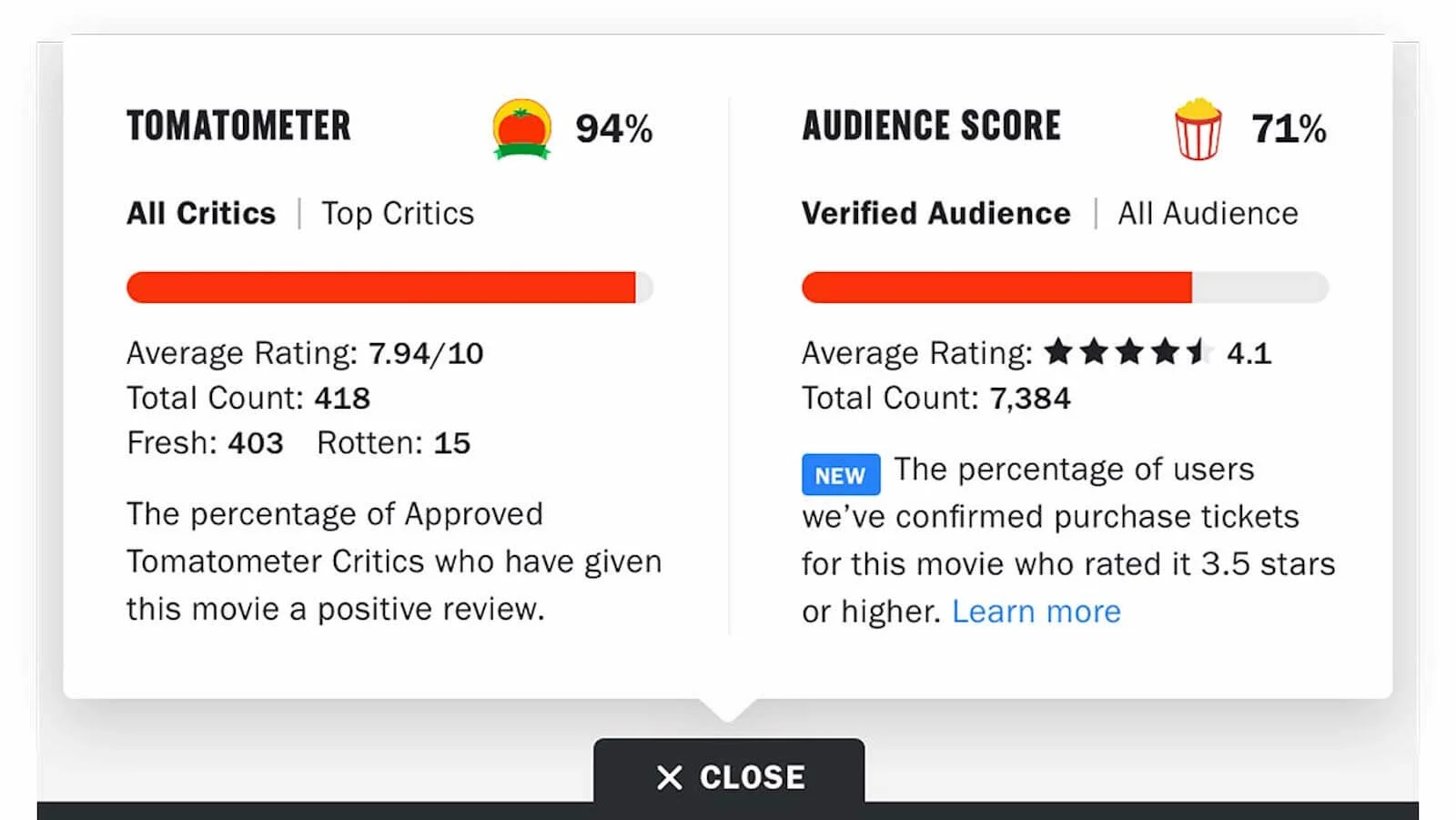
Audience Score Breakdown
Certified Rotten Tomatoes Score
What is Certified Fresh?
What does Rotten Tomatoes mean by Certified Fresh?
If a film or television show is awarded a Certified Fresh status, it’s being acknowledged that it’s met these requirements:
- It has at least five reviews from Top Critics
- A steady Tomatometer score of at least 75%
- Limited release films must have at least 40 reviews
- Wide release films must have at least 80 reviews
- TV shows are eligible by season and must have at least 20 reviews per season
Of course these stats could fluctuate, especially within the first few days or weeks of a film’s release. If it meets these requirements, it is automatically flagged for review.
When the Rotten Tomatoes staff can determine the movie or show is unlikely to fall below these numbers, it achieves its Certified Fresh status.
Similarly, if the Tomatometer score ever falls below 70%, it will lose this status. Because the Rotten Tomatoes ratings system is so general, RT certified fresh consideration gives the site more objective credibility.
What does Rotten Tomatoes mean for movies
Is Rotten Tomatoes good for movies?
So, what's the bottom line? With the movie theater business under constant assault from the rise of streaming services, audiences are less and less likely to venture out to the movies. If they do happen to make it outside the house, they'll likely be extra picky about how they spend their money.
Will they choose an "untested" wildcard movie or one that has general approval from fans and critics? The answer is self-evident. On its surface, the Rotten Tomatoes rating system and Tomatometer seem to be a legitimate resource for the discerning consumer.
However, there is also a legitimate concern for low-budget indie movies who already have the cards stacked against them in distribution. Since they don't have the marketing budget of the Hollywood tentpoles, curious moviegoers have little else to go on besides the Tomatometer. These "little fish" movies live or die by this system, which is ultimately opinion-based and subjective.
Related Posts
Up Next
What is a Cliche? Learn from Examples
If you’re a filmmaker or just love the movies, using cliches are a sure fire way to get awarded a nice big green splat, or a tipped over popcorn bucket. Next up, are some examples of these tired situations and ways to avoid them.
Up Next: Cliche explained →
Share your vision with elegant shot lists and storyboards.
Create robust and customizable shot lists. Upload images to make storyboards and slideshows.
